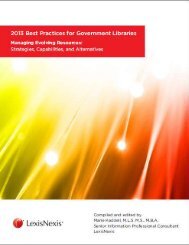2012 Best Practices for Government Libraries
2012 Best Practices for Government Libraries
2012 Best Practices for Government Libraries
You also want an ePaper? Increase the reach of your titles
YUMPU automatically turns print PDFs into web optimized ePapers that Google loves.
118<br />
BEST PRACTICES <strong>2012</strong><br />
To illustrate the process through which the culture changed I will focus on one of<br />
the teams that was set up to look at an emerging intelligence issue. The code name<br />
<strong>for</strong> this team was “Fresh Look.” Fresh Look is discussed in the article but in less<br />
detail than I write about it here.<br />
The Situation<br />
Fresh Look was given the task of finding a solution to a long-standing problem that<br />
many other teams had been unable to resolve. The team was to report their<br />
findings to a high level executive team – tell truth to power.<br />
Previous DIA teams that had struggled to find a solution to this issue had worked<br />
virtually, dividing the work up so that people could function as individual<br />
contributors with minimal interaction. Fresh Look, however, was co-located to give<br />
them the advantage of bringing together their collective knowledge to solve this<br />
difficult problem. But co-location meant that to be successful in using all the team’s<br />
knowledge, the team would have to interact in a Model II manner to jointly address<br />
content issues. To assist the team, early in their time together, the Knowledge Lab<br />
provided the Critical Discourse intervention described above.<br />
Using the Critical Discourse <strong>for</strong>mat, each team member wrote three cases about<br />
their interactions with other Fresh Look team members. By reading and discussing<br />
each other’s cases, team members were able to see, laid out in black and white,<br />
the negative impact of their actions. With practice they began to recognize the<br />
conversational tactics that were in the cases being exhibited in their real time<br />
conversations and begin to call each other on it when they recognized Model I<br />
tactics. With further practice of the Model II skills, they began to be able to share<br />
their knowledge more fully and to speak openly about their concerns related to the<br />
problem they were addressing.<br />
A turning point in terms of new thinking <strong>for</strong> the Fresh Look team came about six<br />
weeks into the project. For some time the team had been struggling with how to<br />
organize themselves to deal with the central issue of their analysis. This issue was<br />
not only at the heart of the Fresh Look topic, but was an issue that touched on the<br />
very nature of how DIA does analysis – so how the team structured themselves and<br />
their work was a very relevant topic <strong>for</strong> the team.<br />
At a Friday meeting, with two of the team members absent, the team finally made<br />
a decision to organize into several smaller teams, each devoted to a piece of the<br />
larger question. The norm within the intelligence community is that when a meeting<br />
is convened and decisions are made, those who were absent are expected to accept<br />
the decision and support it. The rationale being that there is not enough time to<br />
rehash decisions. There is also an implied perception that if the team member had<br />
really wanted to be present at the decision meeting, they would have attended.<br />
On the following Monday the absent team members were back in place <strong>for</strong> the<br />
morning meeting. The absent team members respectfully challenged the decisionmaking<br />
norm by asking the rest of the team to go over their logic <strong>for</strong> reaching the<br />
decision of dividing into several smaller teams. Instead of rebuking the two, the



